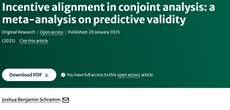A new meta-analysis published in Marketing Letters
 28.01.2025 -
28.01.2025 -
Have you ever wondered whether incentive alignment in conjoint analysis is worth the additional costs? Based on our latest meta-analysis, we would say … yes, it is!
Conjoint analyses are often conducted in hypothetical settings where participants are not sufficiently motivated to invest the same mental effort as in an actual purchase situation. This can lead to significant losses and missed opportunities for companies relying on the resultant biased preferences. One effective workaround is to apply incentive alignment.
Our recent meta-analysis, published in Marketing Letters with 12,980 participants, shows that incentive-aligning conjoint analysis increases the prediction accuracy of consumer choices by 12%.
In the meta-analysis, we also find that incentive alignment is more effective for durable and service goods (compared to FMCGs) and when applied with adaptive choice-based conjoint analysis. The latter mirrors our recent findings from a JAMS article.
Our meta-analysis concludes with practical guidelines for market researchers. These include a detailed discussion on the cost implications of incentive-aligning a conjoint analysis, providing valuable insights and equipping researchers with the necessary knowledge for those considering this approach.
We warmly invite you to explore our open-access article, which comprehensively overviews our research findings. This is your chance to enjoy the article for free and delve deeper into the world of incentive alignment in conjoint analysis.
